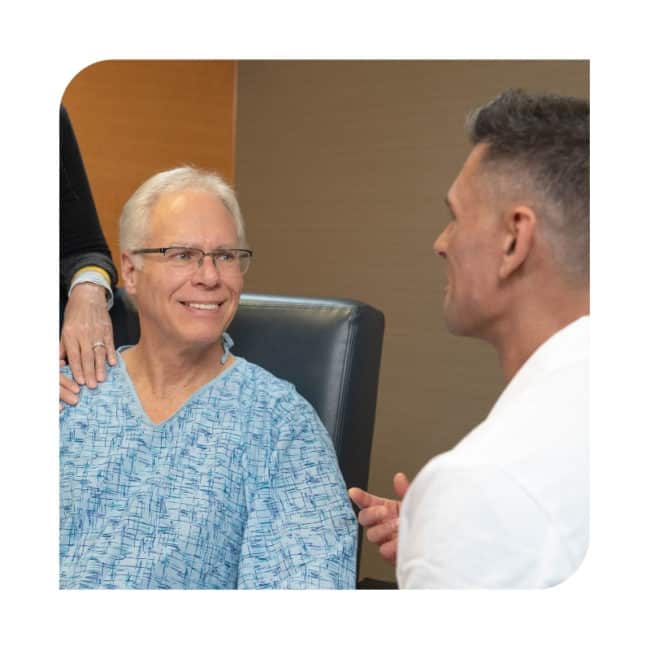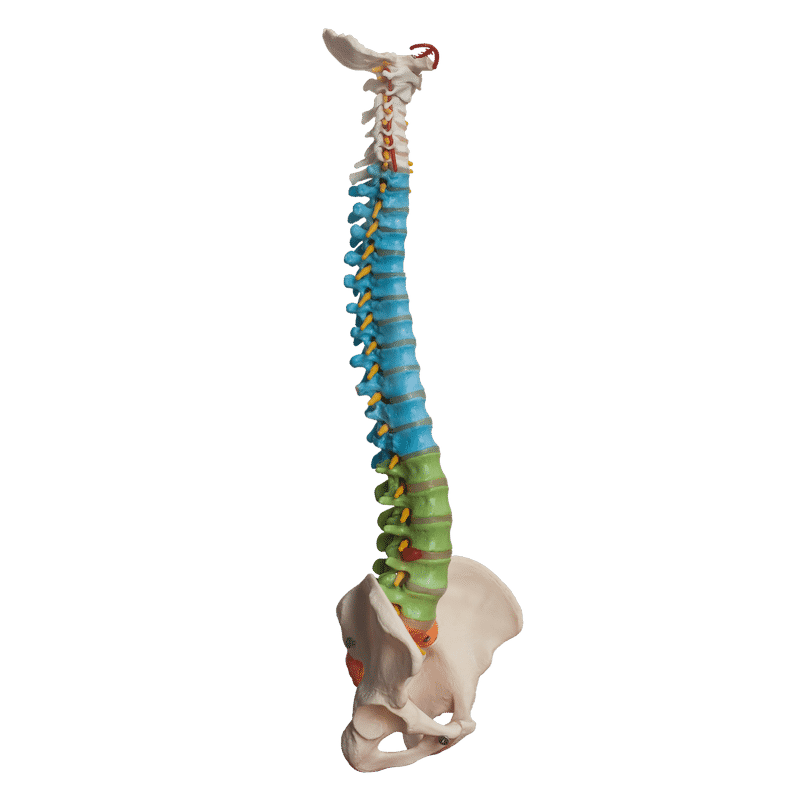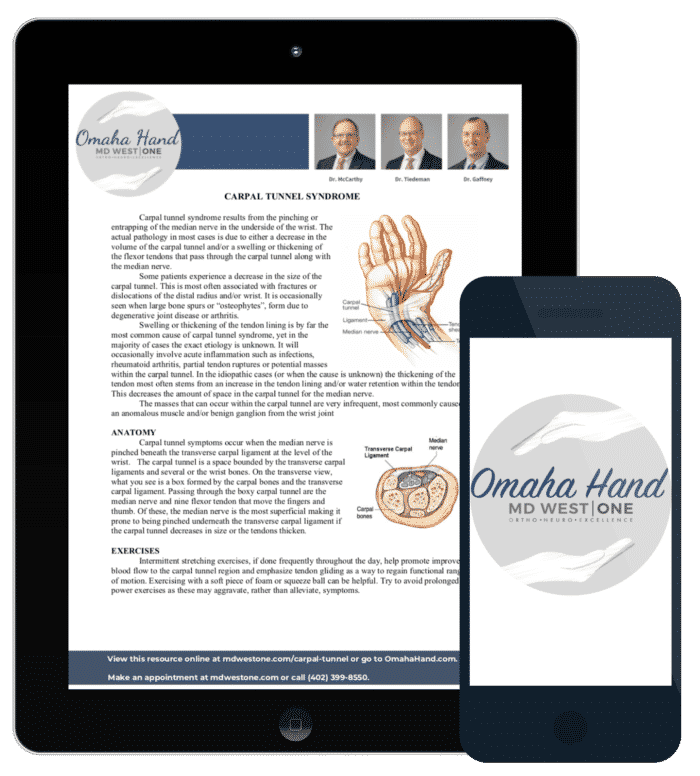Are you suffering from symptoms of Spinal Stenosis?
The Spine doctors at MD West ONE in Omaha are able to properly diagnose and treat spinal stenosis through both surgical and non-surgical treatments. If you have the following symptoms, you may want to make an appointment with one of our Board Certified Spine Specialists.
- Pain in the spine
- Stiffness or numbness in your neck or back
- Sciatica pain - Shooting pains down your leg that can start as an ache in your lower back or buttocks
- Foot drop - painful leg weakness that causes you to “slap” or drop your foot on the ground
- Difficulty standing or walking - imbalance, incoordination, or experiencing more pain when you’re upright
- Loss of bladder or bowel control

Spinal Stenosis Causes, Treatments & Surgery
What is Spinal Stenosis?
Spinal stenosis is a condition in which your spinal canal starts to narrow. This can cause pain and other problems.
Spinal stenosis is a condition in which your spinal canal narrows causing pain and other problems. Spinal stenosis typically affects adults 50 years of age and older. It can affect the entire spine from the cervical spine (neck) to the lumbar spine (low back).
Your spine is composed of a series of connected bones known as vertebrae and shock-absorbing discs. The spine protects your spinal cord and is key to the central nervous system, which connects your brain to the rest of your body. The spinal cord is in the canal formed by your vertebrae, so when the spinal canal narrows, issues may arise.
For most people, the stenosis results from changes because of arthritis. The spinal canal may narrow. The open spaces between the vertebrae may start to get smaller. The tightness can pinch the spinal cord or the nerves around it, causing pain, tingling, or numbness in your legs, arms, or torso.
While there is no cure for spinal stenosis, there are a variety of surgical and non-surgical techniques that the Omaha spinal stenosis treatment experts at MD West ONE can perform to relieve your symptoms and get you back to living a pain-free life. Each case of spinal stenosis is different, outcomes will vary, but MD West ONE will work with you to provide the best possible outcome for your specific case.

What are the causes of Spinal Stenosis?
Arthritis, a condition caused by the breakdown of cartilage, is a common cause of spinal stenosis. Osteoarthritis can lead to the thickening of the ligaments of the spine, bone spurs and disc changes. This can place pressure on your spinal cord and nerves.
Other causes of spinal stenosis include:
- Slipped vertebrae/ Spondylolisthesis
- Herniated discs - If the cushions are cracked, material can seep out and press on your spinal cord or nerves.
- Injuries - An accident may fracture or inflame part of your spine.
- Tumors - If cancerous growths touch the spinal cord, you may get stenosis.
- Paget’s disease - With this condition, your bones grow abnormally large and brittle. The result is a narrowing of the spinal canal and nerve problems.
Some people are born with spinal stenosis or diseases that lead to it. For them, the condition usually starts to cause problems between the ages of 30 and 50.
How is Spinal Stenosis Diagnosed?
The neurosurgeons at MD West ONE in Omaha are spinal stenosis treatment experts. They are highly experienced at finding the source of your back pain and helping you find the appropriate treatment for your condition. When you visit MD West ONE, your doctor will ask questions about your medical history. After that, he or she may order at least one of the following diagnostic tests:
- X-rays - These can show how the shape of your vertebrae has changed.
- Magnetic resonance imaging (MRI) - By using radio waves, an MRI creates a 3-D image of your spine. It can show tumors, growths, and even damage to discs and ligaments.
- Computerized tomography (CT scan) - A CT scan uses X-rays to create a 3-D image. With the help of a dye injected into your body, it can show damage to soft tissue as well as issues with your bones.
Download & Save
Click the button below to download the PDF version of this carpal tunnel information. By downloading the PDF, you can easily print the resource or save it to your desktop or mobile device for future use.

Spinal Stenosis Treatments
After diagnostic testing is complete, our spine specialists will determine if surgery is recommended. MD West ONE prides itself on having a conservative approach to treatment and we will only recommend surgery if it’s absolutely necessary. If our spine specialists determine surgery is not required, we'll work with you to find the best course of treatment to relieve your pain through a wide range of non-surgical treatment techniques. From diagnosis through the entire continuum of care, we will work with you to find appropriate treatments individualized to you.
Spinal Stenosis via Non-Surgical Techniques
Corticosteroid injections
Your doctor will inject a steroid such as prednisone into your back or neck. Steroids make inflammation go down. However, because of side effects, they are used sparingly.
Epidural injection
Used with precision, an injection to block the nerve impulses from the affected spinal segments.
Physical therapy
You can improve your flexibility, strength, and balance with regular exercise and activity. MD West ONE may recommend physical therapy.
Assistive devices
You may get braces, a corset, or a walker to help you move about.
Nontraditional therapies
Many patients also try nontraditional therapies, including chiropractic and acupuncture. Again, be sure your doctor knows if you’re trying a non-traditional approach.
Medication
Common pain medications such as aspirin, acetaminophen (Tylenol), ibuprofen (Advil, Motrin), and naproxen can offer short-term relief. All are available in low doses without a prescription. Other medications, including muscle relaxants and anti-seizure medications, treat aspects of spinal stenosis, such as muscle spasms and damaged nerves.
Surgical Options for Spinal Stenosis
Some people have severe cases. They struggle to walk or have issues with their bladder and bowel. MD West ONE may recommend surgery for these people. The most common procedure, laminectomy, creates space between the bones so inflammation can go down.
Minimally Invasive Surgery & Traditional Surgery
If our spine specialists determine surgery will provide you with the best possible outcome, they'll decide if traditional surgical methods or minimally invasive spine surgery is best. A number of factors are considered, and we pride ourselves on our comprehensive approach and attention to detail in developing the best possible treatment plan specific to you.
Types of Surgery
Three general types of spinal stenosis surgeries, both traditional and minimally invasive include:
- Laminectomy - This is the most common one. Your doctor takes out the bone, spurs, and ligaments that are putting pressure on your nerves. He or she makes either a single incision or several small ones.
- Spinal fusion - Doctors sometimes do this along with a laminectomy, particularly with spinal instability. It involves joining vertebrae together to reduce movement within your spine. Your doctor may use metal screws, rods, or other hardware to connect the vertebrae until new bone grows between them, or they could take bone from somewhere else to spur new growth.
- Foraminotomy - In this procedure, a surgeon opens up the portion of the vertebrae where the nerve roots branch out to the rest of your body.
Surgical Risks
Surgery carries its own risks. MD West ONE will speak with you about how much it can help, what recovery will look like and more specific details unique to your case.
